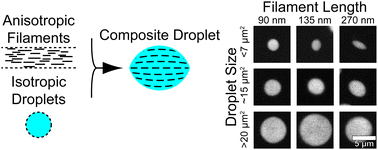Tuning shape and internal structure of protein droplets via biopolymer filaments†
Abstract
Macromolecules can phase separate to form liquid condensates, which are emerging as critical compartments in fields as diverse as intracellular organization and soft materials design. A myriad of macromolecules, including the protein FUS, form condensates which behave as isotropic liquids. Here, we investigate the influence of filament dopants on the material properties of protein liquids. We find that the short, biopolymer filaments of actin spontaneously partition into FUS droplets to form composite liquid droplets. As the concentration of the filament dopants increases, the coalescence time decreases, indicating that the dopants control viscosity relative to surface tension. The droplet shape is tunable and ranges from spherical to tactoid as the filament length or concentration is increased. We find that the tactoids are well described by a model of a quasi bipolar liquid crystal droplet, where nematic order from the anisotropic actin filaments competes with isotropic interfacial energy from the FUS, controlling droplet shape in a size-dependent manner. Our results demonstrate a versatile approach to construct tunable, anisotropic macromolecular liquids.



 Please wait while we load your content...
Please wait while we load your content...
